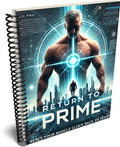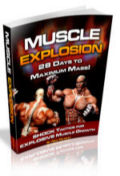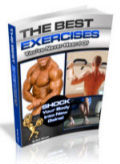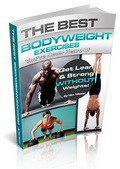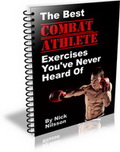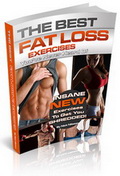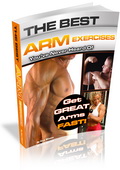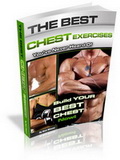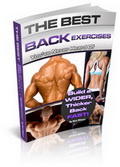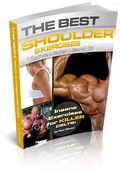 |
| Affiliate Area Home | Getting Started & FAQ | 42 Part Affiliate Training Course and Videos |
|
|
The Best Arm Exercises
|
|
On this page, I've got a "sample" review of "The Best Arm Exercises" book. You're welcome to publish it as-is or pick it apart and rewrite and use whatever you like from it. It's written from an analytical viewpoint - no hype but designed to draw interest in the book and minimize any perceived objections. You can email this directly to your list and/or publish it on your website or blog, so it continues to generate traffic and sales for you (recommended). |
|
The Best
Arm Exercises You've Never http://hop.clickbank.net/?XXXXX/betteru&l=800 Review So what's the first thing you think of when you think of "arm training" - if you're like a lot of trainers, you immediately think barbell curls and pushdowns. Or dumbell curls and dips, etc. The "standard" exercises, right? Well, it's time to think outside the box! Or as Nick Nilsson (the author of "The Best Arm Exercises You've Never Heard Of") puts it...time to make a NEW box and think outside of THAT one! "The Best Arm Exercises" is a very interesting book...68 unique exercises for the bicep, triceps and forearms ONLY. This is thing has NO fluff - it's just packed with training information.
That's the first question I asked Nick when he first sent this book along to me for a review. After all, the trend right now is more towards functional and "total body" styles of training. Direct and/or isolated arm work seems to take a back seat to that type of approach these days. Basically, is this just for fun or just fluff training? So here's his reasoning as to why direct arm training should be done...as he was telling me this stuff, it really made a lot of sense.
Let's say your bench press has been stuck in a plateau because you have trouble fully locking the bar out at the top. That top range of motion is a primarily triceps. By directly working the triceps with effective "assistance" exercises, you can immediately see results that carry over to your big movements. Obviously, any pressing movement is going to have a substantial tricep component. What about biceps? Bicep strength plays an important role in rowing and pulling exercises, like chin-ups, bent-over rows...even deadlifts. Remember...your body is only as strong as it's weakest link. If you're doing a bench press and your triceps are relatively weaker than your chest, it's going to LIMIT the amount of weight you can push. By directly strengthening your weak links, you can improve your total strength in the big lifts. Same for an exercise like chin-ups. Your back may be strong, but if your bicep (or even forearm!) strength limits your training, you'll never maximize your performance in that exercise. A targeted application of direct arm training can really make a big difference in your lifting. And, of course, you need to use EFFECTIVE exercises for this purpose, otherwise you're wasting your time. "The Best Arm Exercises" has some EXTREMELY targeted stuff that certainly fits the bill as big exercise "assistance" exercises.
Obviously, a book full of 68 new exercises is going to give you a LOT of variety to choose from. Your body thrives on variety and change...you still DO need to maintain a level of consistency to achieve a training effect, but something as simple as a new exercise or a new way of doing something can really spark results. Nick actually acknowledges this as well - in his own training, he tells me that it's about 75% "normal" stuff...squats, deadlifts, bench press, that kind of thing. The other 25% is a rotation of the unique exercises you see presented in his books and on his sites. You really do HAVE to keep some consistency in order to see results - perform random exercises without regard to adaptation just won't get you anyway. When I asked Nick about this specific point as it relates to his book, he said... "Here's the approach you have to take with this type of resource - take your time with it and pick out a few exercises you want to try. Use them the next time you train arms and see how they work for you. Generally speaking, if an exercise is going to work for you, you'll feel it pretty quickly. Stick with the ones you get the biggest effect from then gradually work in OTHER exercises on a rotational basis like a continuous audition process at a soap opera. As good as these exercises are, I'm quite sure there will be ones that don't work equally as well for everybody. You have to experiment and find out what works best for YOU. Then work it HARD!"
Let's say you've been training the "Big 3" lifts (squat, bench, and deadlift) a LOT and for a LONG time. There comes a time when you need to back off and "deload", reducing your training volume for recovery purposes. If you keep hammering away at heavy exercises, your body breaks down...muscle, connective tissue and nervous system. That's when injuries happen. And this is the perfect time to work in some unique exercises like the ones Nick has in his book - you can use this time to build strength in your weaker muscle groups and really target your weak points.
One of the nice things Nick has done with this book is include plenty of compound exercises for the arms...not hard to find for the triceps in the scope of normal exercises (think of dips, close grip bench press, etc.) but generally a bit tougher to find for biceps...it's usually all curls. Several of the exercises are variations of pull-ups or rows that make adjustments in setup and/or execution in order to change the focus from back to biceps. They're VERY simple to execute and WOW do they really have potential. The real standout exercise in that department is the Nilsson Curl, which can be best described as a chin-up with your forearms braced against a bar set about a foot lower than the one you're gripping on. As Nick explains it, this bracing keeps you from being able to pull your body straight up, which normally engages the lats. By blocking your forearms like this, it forces you to pull yourself up and around in an arc with the elbow as the pivot. This is almost ALL biceps (80 to 90%) with assistance being provided by the lats instead of the other way around. You can actually SEE this exercise in action as one of the sample exercises on Nick's site for the book. It's a very cool exercise and it's a great twist on a classic exercise to really shift the focus to the biceps and work them with a compound exercise.
Yes, arm training IS fun and SHOULD be fun! The real "meat and potatoes" work is done under the squat bar and at the deadlift, but there's nothing wrong with enjoying training those "mirror" muscles from time to time, too. :)
When you get this book, you're obviously getting a book about exercises. But One thing that would be a nice addition would be some targeted sample workouts for working those exercises into a program. These exercises are so unique, that it might be hard some trainers to figure exactly how to best use these in a program. I asked Nick about this and he said he's actually got several unannounced bonus gifts for people when they pick up the book that will address this exact thing. He wanted to keep it as a surprise, as a way of saying "thanks" but if it's the lack of programs really shouldn't be something that should hold you back from getting this book. The other thing that I can see is that there aren't that many forearm exercises in the book (5 for the forearms as compared to 33 for the biceps and 30 for the triceps). Nick told me he's going to be addressing this in updates to the book as he definitely knows the forearm stuff needs to be built on. Here's the thing... When you get the book, you'll also get free updates for life, so those forearm exercises are going to be something you'll be getting soon enough...as if the other 63 exercises aren't plenty to keep going for a long time anyway! The last thing I should mention is that if you're limited on equipment, there will be a few exercises that you won't be able to perform...there are a few that require cable machines (though creative use of training bands/elastics would be a good substitute) and a few that require a power rack. But even with fairly BASIC equipment like a bench and some free weights, you'll be able to perform the VAST majority of these exercises just fine. Several of them require no equipment at all or things that can very easily be improvised.
Now, if you've seen the exercises that Nick has created before, you'll know exactly what this book is all about...very cool, very effective exercises that will have everybody in your gym coming up and asking you what the heck you're doing. These exercises are very well thought out and have a lot of potential both for improving your arms AND for helping improve your "big" exercises through assistance training. Plus, the exercises are just plain fun! To learn more about this book and to grab your copy right now: http://hop.clickbank.net/?XXXXX/betteru&l=800 |
Click here to return to the Best Arm Exercises Ads and Tools page.
|
